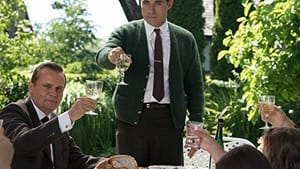Stay in the Loop
BSR publishes on a weekly schedule, with an email newsletter every Wednesday and Thursday morning. There’s no paywall, and subscribing is always free.
Baseball, apple pie, and swastikas
'The Man in the High Castle' on Amazon

Ah, those carefree days of summer. A time for cookouts and family gatherings, a time to celebrate the national holiday with fireworks and patriotic displays. As you usher your houseguest into the front door, you take time out to wave to your neighbor across the street. "Hey, Harry!" you say. Harry waves back with a smile and a "Sieg Heil!" and you give a cheery "Sieg Heil!" in response.
Wait a minute. This is the United States of America. Nobody would say such a thing here, would they?
You would if you were SS Obergruppenführer John Smith, leader of the New York SS in the Greater Nazi Reich, and you were celebrating not Independence Day, but VA (Victory over America) Day. The year is 1962, Nazi Germany and Imperial Japan have won World War II, and this is the alternate reality of The Man in the High Castle, the Amazon Studios miniseries. Based on the Hugo Award-winning Philip K. Dick novel of the same title, the ten-episode series was developed by former X-Files writer/producer Frank Spotnitz and executive producer Ridley Scott.
As my BSR colleague Tom Purdom explains in his recent essay, alternate history is a literary subgenre popular in (but not exclusive to) science fiction, and The Man in the High Castle is a revered masterpiece of the form. In Dick's novel, the victorious Axis powers have divided America in two, with Japan ruling the west and Germany the east, the nation fully occupied save for a neutral buffer state along the Rocky Mountains. Dick follows several separate characters as they try to exist and thrive in this dark world, all connected by the mystery of a notorious underground novel called The Grasshopper Lies Heavy — which itself is an alternate history tale showing the Allies winning WWII (i.e., our reality).
If that sounds a bit mindbending, that's because it is, and such explorations of reality and unreality, perception and illusion, are trademarks of Philip K. Dick's work. The Amazon series is considerably more grounded and dynamic than the novel, but no less compelling. It's more an extended original riff on the book's basic premise than a straightforward adaptation, but it manages to preserve the novel's original flavor while expanding on one of its most powerful themes: the practical, emotional, and spiritual costs of life under fascism. [Spoiler alert: The following synopsis reveals numerous plot twists.]
Who’s allied with who?
The costs are brought home forcefully in the first episode, when Juliana Crain (Alexa Davalos), living in Japanese-ruled San Francisco with boyfriend Frank Frink (Rupert Evans), sees her half-sister Trudy killed in the streets by the Kempeitai, the Japanese secret police. Juliana learns that Trudy had been entrusted to pass along a mysterious reel of film for the underground Resistance movement, and she finds herself drawn into the Resistance herself, leading her to the Rocky Mountains Neutral Zone and a meeting with Joe Blake (Luke Kleintank), a truck driver who's also ostensibly working for the Resistance. . .except that he's not. He's really an undercover agent sent by Obergruppenführer Smith (Rufus Sewell) to ferret out the secrets of the Resistance and to track down copies of The Grasshopper Lies Heavy, a series of enigmatic newsreel films showing a world in which Germany and Japan lost the war. Meanwhile, Japanese Trade Minister Nobusuke Tagomi (Cary-Hiroyuki Tagawa) is engaged in his own intrigues, meeting with Nazi diplomat Rudolph Wegener (Carsten Norgaard) as they try to prevent an impending catastrophic war between Germany and Japan.

The plotlines are all quite complex, absorbing, and masterfully interwoven, brought together by the common touchstones of The Grasshopper Lies Heavy and the attempted assassination in San Francisco of the visiting crown prince of Japan. The characters face innumerable compromises, deceptions, moral choices, and conflicts, both petty and profound, that result from living in a world in which a random word, a careless action, or a failure to show the proper deference at the proper time can be, literally, fatal. That's true even for a figure such as Obergruppenführer Smith, a man whose position grants him awesome power and apparent invulnerability (even after he survives his own attempted assassination), but who, as the ten episodes of the first season progress, is forced to face some wrenching personal conflicts of his own.
In The Man in the High Castle, no one escapes. No one is completely clean, no one is snow-white absolute purity or blackhearted absolute evil, no one escapes the hook of human morality. Whether they are among the exalted rulers or the groveling, deferential ruled, all of the characters deal with external and internal quandaries on multiple levels. Each, whether by choice or necessity, is forced to harbor a hidden agenda, play a role, show one face to the world while hiding another. The moral corruption of a political and social system that routinely subjugates and suppresses the basic worth and dignity of human beings takes a devastating toll on every person.
Symbols transformed
Apart from the stellar writing and acting, the design and visual details of The Man in the High Castle are stunning. The opening credits, set over the deceptively innocuous strains of "Edelweiss" from The Sound of Music, comprise some of the most chilling minutes ever seen on American TV, visually depicting the fall of the U.S.A. to the Axis powers. Then there's the wrenching sight of seeing swastikas where one is used to seeing stars and stripes, of seeing Hitler or Hirohito where one is used to seeing Washington or Lincoln. The absolute subjugation of America is nowhere more evident than in the mundane pervasiveness of such imagery. A recent flap in New York City proved the point in the real world: When Amazon advertised the series on a single subway train using the Nazified American flag from the show, a prompt storm of outrage made Governor Andrew Cuomo himself call for the ads to be withdrawn.
The success of the series has ensured a second season, which will no doubt answer some of the unresolved questions posed by the first. Who is "the man in the high castle?" Where does The Grasshopper Lies Heavy come from, and what does it mean? What do the antique dealer Robert Childan's (Brennan Brown) musings of the reality and unreality of "historicity" have to do with it all? And what about the ending of the last episode, which was definitely the most "Phildickian" (the accepted adjective among SF fans) moment of the whole series thus far?
As with all the best fiction, we are given no easy answers, but are inspired to speculate, think, and ask more questions. But there is one issue that The Man in the High Castle has already settled quite conclusively. Whatever the imperfections and injustices of the real-life United States, we're indeed fortunate to live in a place where we wave stars and stripes instead of swastikas, and wish each other a Happy Independence Day rather than Happy VA Day.
What, When, Where
The Man in the High Castle. Developed by Frank Spotnitz, based on the novel by Philip K. Dick. An Amazon original series.
Sign up for our newsletter
All of the week's new articles, all in one place. Sign up for the free weekly BSR newsletters, and don't miss a conversation.

 Mark Wolverton
Mark Wolverton